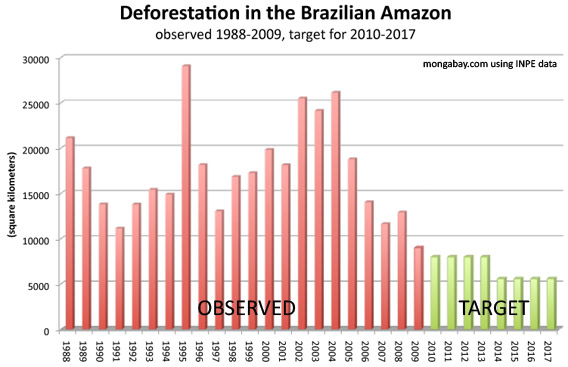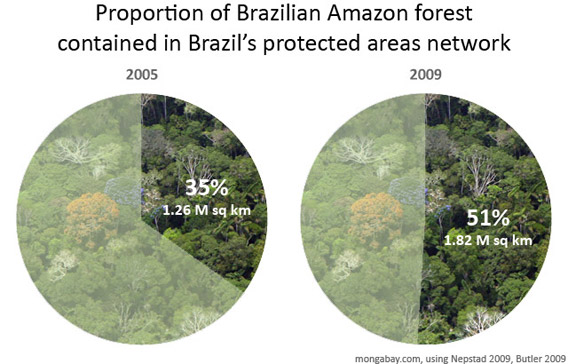Summary:
Brazil’s development bank BNDES has announced the first five recipients of grants under the South American country’s ambitious Amazon Fund, which aims to reduce deforestation by 70 percent over the next decade.
The recipients include US$ 11 million for the Bolsa Floresta program, which compensates forest communities in the state of Amazonas for avoiding deforestation; Imazon (Instituto do Homem e Meio Ambiente da Amazônia), which will receive $5.5 million to create an environmental land registry and monitoring capabilities in the state of Pará; TNC Brasil, which will get $9.1 million to encourage wood producers, cattle ranchers and soy farmers in Pará and Mato Grosso to sign up for a land registry that promotes environmental stewardship; the Projeto Sementes do Portal; which will receive $3.1 million to develop reforestation projects on degraded lands in Mato Grosso; and the Fundo Brasileiro para a Biodiversidade, which will get $11.5 million to support the second phase of the Arpa Program responsible for establishing new protecting areas.
 Brazil’s proposed targets for reducing deforestation: |
All together some $40 million will be allocated to the initiatives, or just over a third of the $110 million of the money raised from Norway for the Amazon Fund in 2009. Norway has committed 750 million krone (about US$ 125 million) for 2010 and up to one billion by 2016.
The Amazon Fund represents Brazil’s effort to reduce greenhouse gas emissions from deforestation. As the world’s top deforester over the past decade, forest loss accounts for more than 60 percent of Brazil’s total CO2 emissions.

|
The Amazon Fund, which aims to raise more than $20 billion from foreign donors over the next decade — will target investments in forest protection and efforts to sustainably use forest resources. The fund will support sustainable forest management, land-use planning and land-title regularization, reforestation and forest recovery, environmental monitoring, the development of sustainable industries, and establishment of new protected areas. 20 percent of the funds have been ear-marked for developing systems to monitor and control deforestation outside the Brazilian Amazon, including other ecosystems within Brazil and other countries.
Related articles
Brazil could halt Amazon deforestation within a decade

(12/03/2009) Funds generated under a U.S. cap-and-trade or a broader U.N.-supported scheme to reduce greenhouse gas emissions from deforestation and degradation (“REDD”) could play a critical role in bringing deforestation in the Brazilian Amazon to a halt, reports a team writing in the journal Science. But the window of opportunity is short — Brazil has a two to three year window to take actions that would end Amazon deforestation within a decade.
Brazil’s plan to save the Amazon rainforest

(06/02/2009) Accounting for roughly half of tropical deforestation between 2000 and 2005, Brazil is the most important supply-side player when it comes to developing a climate framework that includes reducing emissions from deforestation and forest degradation (REDD). But Brazil’s position on REDD contrasts with proposals put forth by other tropical forest countries, including the Coalition for Rainforest Nations, a negotiating block of 15 countries. Instead of advocating a market-based approach to REDD, where credits generated from forest conservation would be traded between countries, Brazil is calling for a giant fund financed with donations from industrialized nations. Contributors would not be eligible for carbon credits that could be used to meet emission reduction obligations under a binding climate treaty.
Brazil accounts for 74% of global land area protected since 2003
(06/01/2009) Brazil accounts for nearly three-quarters of land protected in conservation areas established since 2003, according to a new study published in the Biological Conservation.
How to save the Amazon rainforest
(01/04/2009) Environmentalists have long voiced concern over the vanishing Amazon rainforest, but they haven’t been particularly effective at slowing forest loss. In fact, despite the hundreds of millions of dollars in donor funds that have flowed into the region since 2000 and the establishment of more than 100 million hectares of protected areas since 2002, average annual deforestation rates have increased since the 1990s, peaking at 73,785 square kilometers (28,488 square miles) of forest loss between 2002 and 2004. With land prices fast appreciating, cattle ranching and industrial soy farms expanding, and billions of dollars’ worth of new infrastructure projects in the works, development pressure on the Amazon is expected to accelerate. Given these trends, it is apparent that conservation efforts alone will not determine the fate of the Amazon or other rainforests. Some argue that market measures, which value forests for the ecosystem services they provide as well as reward developers for environmental performance, will be the key to saving the Amazon from large-scale destruction. In the end it may be the very markets currently driving deforestation that save forests.